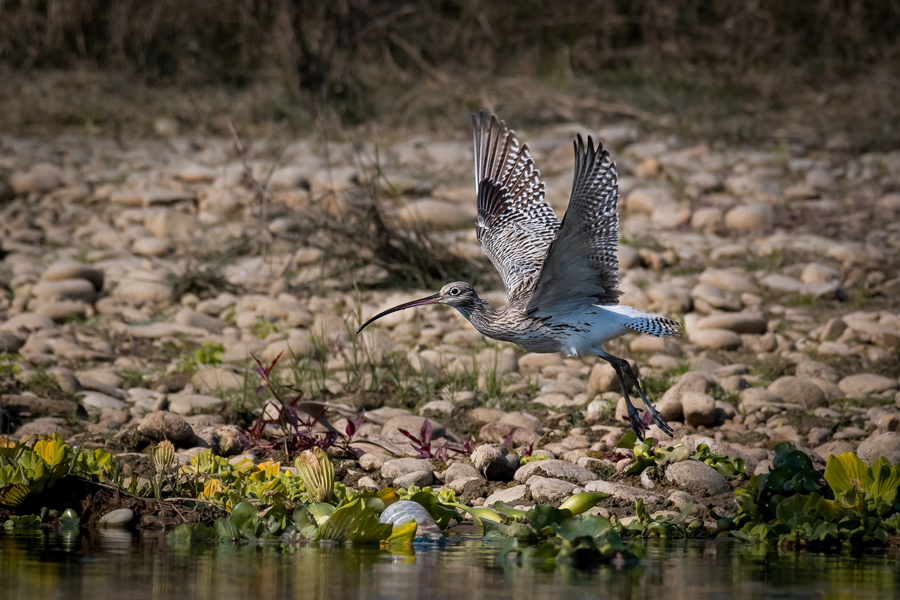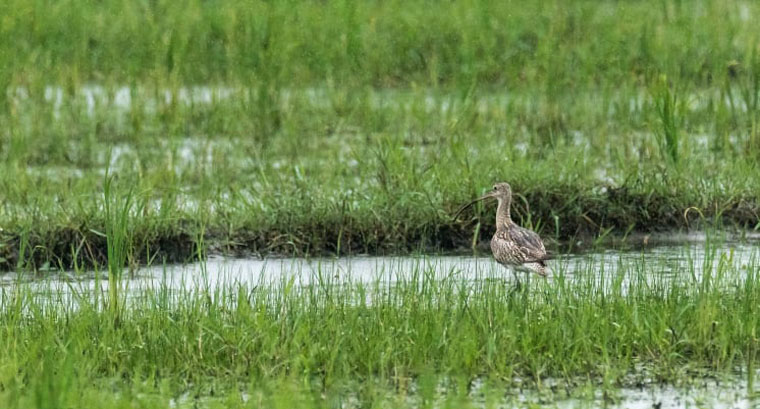Eurasian Curlew visits Kathmandu after 50 years

They once used to arrive in flocks of 200 in Kosi Tappu wildlife reserve, and frequent Kathmandu Valley’s wetlands. But after their numbers started dwindling sharply, the first Eurasian Curlew has been spotted for the first time after half-a-century by birders in Kathmandu last week.
A group of wildlife photographers were out taking pictures along the Manahara River in Bhaktapur when they spotted a brownish bird with a long curved beak feeding by itself along the shore. They took close-up photographs and showed it to Hem Sagar Baral, an ornithologist with the Zoologial Society London (ZSL) who positively identified it as the Eurasian Curlew.
Sanjay Shrestha and Pemba Sherpa took pictures of the bird on the ground, while others in the group have photos of the bird in flight. What intrigued Baral is that Eurasian Curlews are usually in flocks, and this seemed to be on its own.
The bird used to be a common autumn visitor in Nepal’s national parks as they made stopovers in their migrations to and from Siberia and India, and possibly as far away as Africa. The birds of passage even used to make a refueling stop for a few days in Kathmandu Valley, but had not been seen here for 50 years.

The bird used to be abundant in Kosi Tappu Wildlife Reserve and has also been spotted lately in Chitwan, but not in large numbers. Eurasian Curlews use their characteristic curved beaks to burrow into wet sand banks after monsoon floods for worms.
The first person to identify a Eurasian Curlew in Kathmandu was the British resident Brian Hodgson in 1844, who reported seeing flocks of them stopping over briefly on their migration. Ornithologist R L Fleming and artist Lain Singh Bangdel in their 1976 book, Birds of Nepal, say the bird is found in Kathmandu Valley. H S Nepali in his unpublished work in 1982, List of Nepalese Bird Specimens, also reports that the bird is found in Kathmandu. However, both bird books probably relied on an earlier sighting in 1970.
Till 20 years ago, Anish Timilsina of the Kosi Tappu Wildlife Reserve remembers seeing flocks of up to 200 stopping by the river banks to feed, usually in the autumn season. They even used to winter there because of the abundance of food. But for the past decade, he said, they come only in groups of three or four, and some years there are none at all.

The International Conservation Union (IUCN) has classified the Eurasian Curlew in the threatened list. Their numbers are also going down in the British Isles, which had up to quarter of the population of the birds, and has not been put on the Red List of endangered birds. The reason is habitat loss as wetlands disappear, water pollution and hunting.

The reasons are similar in Nepal – the loss of wetlands as well as the disappearance of sand banks and mud flats by rivers where the birds prefer to feed. Their numbers could have also dwindled because of hunting and habitat loss in stopovers en route during migration.
The Eurasian Curlew is among five species of migratory birds whose numbers have diminished since 2000, including the Eurasian Spoonbill, Pallas Fish Eagle, Caspian Tern. Some 212 of the 896 bird species found in Nepal are migratory, and 42 of them are globally threatened.




